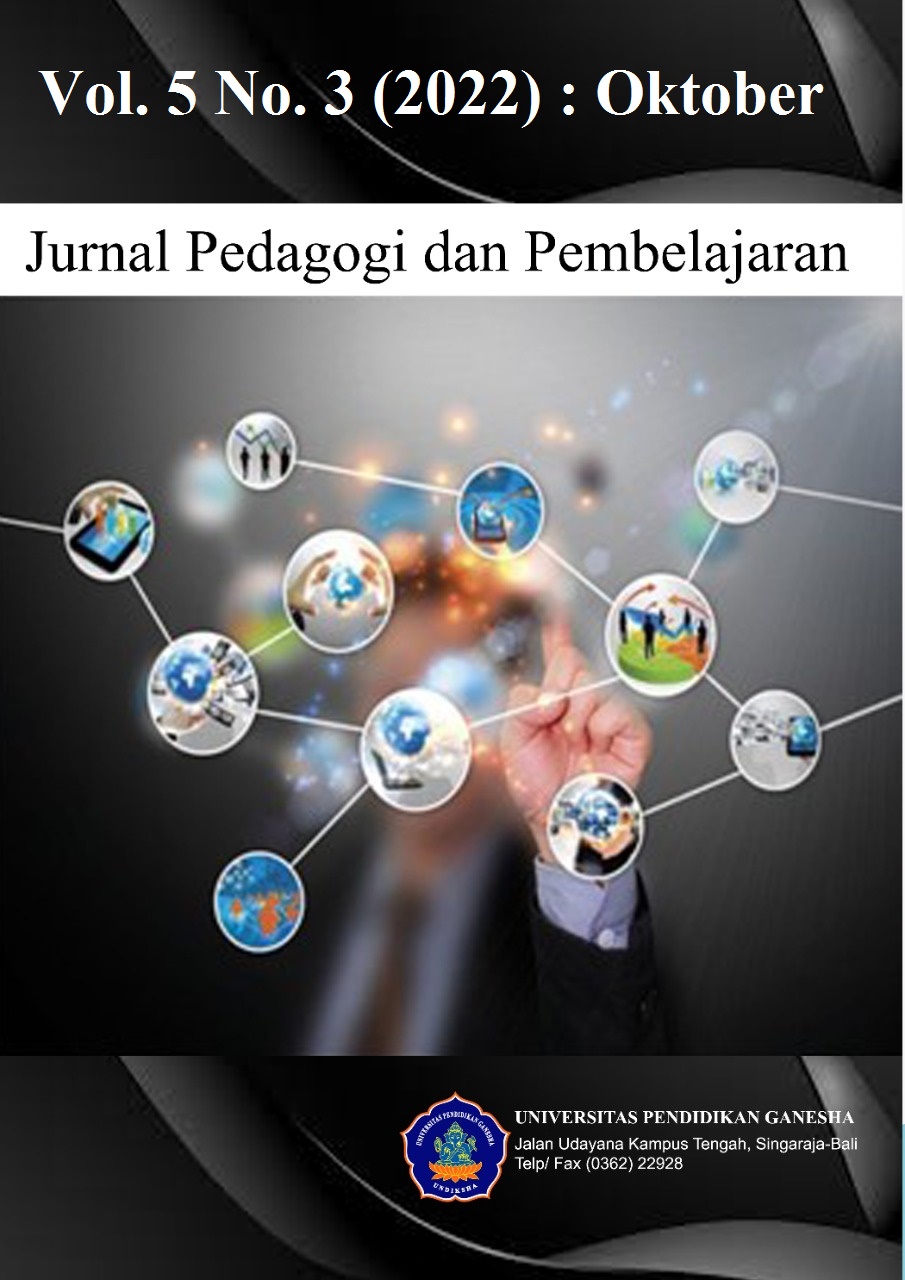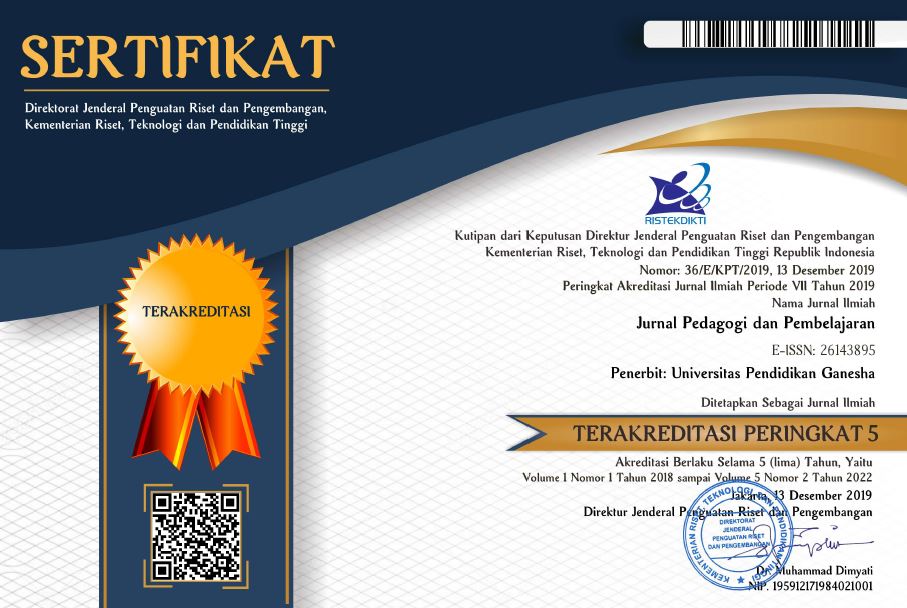Youth Teachers Program in Information Technology Management
DOI:
https://doi.org/10.23887/jp2.v5i3.53014Kata Kunci:
Teachers, Information Technology, ManagementAbstrak
Quality management is a tool that allows teachers to adapt to the forces of change hitting the education system, the knowledge needed to improve our education system already exists within the education community itself. The main difficulty faced by teachers today is their inability to deal with the new system so that it becomes a problem for teachers to develop or implement new educational processes that will improve the quality of education. This study aims to analyze the results of independent and simultaneous evaluations in terms of context, input, process, product, and the constraints in the Young Teacher Training program in the management of information and communication technology. This research was a program evaluation research with the CIPP model. The population of this study was 69 educators and administrative staff. The samples of the study were selected using a random sampling technique. Data regarding context, input, process, and product in this study were collected using a questionnaire using a Likert scale of 1-5. The data analysis method used in this research is the quantitative descriptive analysis method. The analysis found that the Young Teachers' Program in managing information technology has proven to be effective in terms of context, input, process, and product, both independently and simultaneously. However, some technical and non-technical obstacles are still experienced during program implementation.
Referensi
Ambussaidi, I., & Yang, Y.-F. (2019). The Impact of Mathematics Teacher Quality on Student Achievement in Oman and Taiwan. International Journal of Education and Learning, 1(2), 50–62. https://doi.org/10.31763/ijele.v1i2.39. DOI: https://doi.org/10.31763/ijele.v1i2.39
Andarwulan, T., Al Fajri, T. A., & Damayanti, G. (2021). Elementary teachers’ readiness toward the online learning policy in the new normal era during Covid-19. International Journal of Instruction, 14(3), 771–786. https://doi.org/10.29333/iji.2021.14345a. DOI: https://doi.org/10.29333/iji.2021.14345a
Anthony C. Inciso, A. (2021). Higher Education during COVID-19 Pandemic: Distance Education and Online Learning. International Journal of Research Publications, 70(1), 60–65. https://doi.org/10.47119/ijrp100701220211746. DOI: https://doi.org/10.47119/IJRP100701220211746
Arifa, F. N. (2020). Tantangan pelaksanaan kebijakan belajar dari rumah dalam masa darurat covid-19. Info Singkat: Kajian Singkat Terhadap Isu Aktual Dan Strategis, 7(1), 13–18. https://berkas.dpr.go.id/sipinter/files/sipinter-630-989-20200707165734.pdf.
Arikunto, S., & Safruddin, C. (2009). Evaluasi Program Pendidikan. Bumi Aksara.
Armstrong-Mensah, E., Ramsey-White, K., Yankey, B., & Self-Brown, S. (2020). COVID-19 and Distance Learning: Effects on Georgia State University School of Public Health Students. Frontiers in Public Health, 8(September), 1–10. https://doi.org/10.3389/fpubh.2020.576227. DOI: https://doi.org/10.3389/fpubh.2020.576227
Baber, H. (2021). Modelling the acceptance of e-learning during the pandemic of COVID-19-A study of South Korea. The International Journal of Management Education, 19(2), 100503. https://doi.org/10.1016/j.ijme.2021.100503. DOI: https://doi.org/10.1016/j.ijme.2021.100503
Bhuana, G. P., & Apriliyanti, D. L. (2021). Teachers’ encounter of online learning: Challenges and support system. Journal of English Education and Teaching, 5(1), 110–122. https://doi.org/10.33369/jeet.5.1.110-122.
Cahyadi, A., Hendryadi, Widyastuti, S., Mufidah, V. N., & Achmadi. (2021). Emergency remote teaching evaluation of the higher education in Indonesia. Heliyon, 7(8), e07788. https://doi.org/10.1016/j.heliyon.2021.e07788. DOI: https://doi.org/10.1016/j.heliyon.2021.e07788
Clark, L. S. (2009). Digital media and the generation gap. Information Communication and Society, 12(3), 388–407. https://doi.org/10.1080/13691180902823845. DOI: https://doi.org/10.1080/13691180902823845
de la Peña, D., Lizcano, D., & Martínez-Álvarez, I. (2021). Learning through play: Gamification model in university-level distance learning. Entertainment Computing, 39(March). https://doi.org/10.1016/j.entcom.2021.100430. DOI: https://doi.org/10.1016/j.entcom.2021.100430
Duffuaa, S. O., & Raouf, A. (2015). Planning and Control of Maintenance Systems. In Planning and Control of Maintenance Systems. https://doi.org/10.1007/978-3-319-19803-3. DOI: https://doi.org/10.1007/978-3-319-19803-3
Erwinsyah, A. (2016). Pengelolaan Pembelajaran Sebagai Salah Satu Teknologi dalam Pembelajaran. Tadbir: Jurnal Manajemen Pendidikan Islam, 4(2), 80–94. https://www.journal.iaingorontalo.ac.id/index.php/tjmpi/article/view/442.
Febriansyah, D., Dwiputra, K., Budiyanto, T. M., & Adz, T. (2020). Textbooks Transformation Into Digital Comics As Innovative Learning Media for Social Science Studies in Junior High School. International Journal Pedagogy of Social Studies, 5(2), 9–16. https://doi.org/10.17509/ijposs.v5i2.29068.
Gómez-García, M., Hossein-Mohand, H., Trujillo-Torres, J. M., & Hossein-Mohand, H. (2020). The training and use of ICT in teaching perceptions of melilla’s (spain) mathematics teachers. Mathematics, 8(10). https://doi.org/10.3390/MATH8101641. DOI: https://doi.org/10.3390/math8101641
Hadisi, L., & Muna, W. (2015). Pengelolaan Teknologi Informasi Dalam Menciptakan Model Inovasi Pembelajaran (E-learning). Jurnal Al-Ta’dib, 8(1), 117–140. https://ejournal.iainkendari.ac.id/index.php/al-tadib/article/view/396/380.
Hill, J. B. (2021). Pre-Service Teacher Experiences during COVID 19: Exploring the Uncertainties between Clinical Practice and Distance Learning. Journal of Practical Studies in Education, 2(2), 1–13. https://doi.org/10.46809/jpse.v2i2.18. DOI: https://doi.org/10.46809/jpse.v2i2.18
Issa, T., & Isaias, P. (2016). Internet factors influencing generations Y and Z in Australia and Portugal: A practical study. Information Processing & Management, 52(4), 592–617. https://doi.org/10.1016/j.ipm.2015.12.006. DOI: https://doi.org/10.1016/j.ipm.2015.12.006
Jiang, M. Y.-C., Jong, M. S.-Y., Lau, W. W.-F., Meng, Y.-L., Chai, C.-S., & Chen, M. (2021). Validating the General Extended Technology Acceptance Model for E-Learning: Evidence From an Online English as a Foreign Language Course Amid COVID-19. Frontiers in Psychology, 12, 671615. https://doi.org/10.3389/fpsyg.2021.671615. DOI: https://doi.org/10.3389/fpsyg.2021.671615
Karakose, T., Polat, H., & Papadakis, S. (2021). Examining Teachers’ Perspectives on School Principals’ Digital Leadership Roles and Technology Capabilities during the COVID-19 Pandemic. In Sustainability (Vol. 13, Issue 23). https://doi.org/10.3390/su132313448. DOI: https://doi.org/10.3390/su132313448
Khalid, M. S. (2011). ICT in Education: Secondary Technical Vocational Education and Training Institute Centered Diffusion of Innovation in Rural Bangladesh. In International Technology, Education and Development Conference (pp. 1126–1134). International Association of Technology, Education and Development (IATED).
Kim, D. J., Choo, E. K., & Ranney, M. L. (2014). Impact of gender on patient preferences for technology-based behavioral interventions. The Western Journal of Emergency Medicine, 15(5), 593–599. https://doi.org/10.5811/westjem.2014.4.21448. DOI: https://doi.org/10.5811/westjem.2014.4.21448
Kocak, A., & Yuksek, O. (2019). Group-Based Communication: Contents And Practices Of Whatsapp Group Use. Online Journal of Communication and Media Technologies, 9(4), 1–14. https://doi.org/10.33422/icarsh.2019.03.188. DOI: https://doi.org/10.33422/icarsh.2019.03.188
Kurz, C. J., Li, G., & Vine, D. J. (2019). Are millennials different?∗. In A. Haughwout & B. B. T.-H. of U. S. C. E. Mandel (Eds.), Handbook of US Consumer Economics (pp. 193–232). Academic Press. https://doi.org/10.1016/B978-0-12-813524-2.00008-1. DOI: https://doi.org/10.1016/B978-0-12-813524-2.00008-1
Kuss, D. J., Kanjo, E., Crook-Rumsey, M., Kibowski, F., Wang, G. Y., & Sumich, A. (2018). Problematic Mobile Phone Use and Addiction Across Generations: the Roles of Psychopathological Symptoms and Smartphone Use. Journal of Technology in Behavioral Science, 3(3), 141–149. https://doi.org/10.1007/s41347-017-0041-3. DOI: https://doi.org/10.1007/s41347-017-0041-3
Laksana, N. Y., & Fadhilah, A. (2021). Computer-mediated communication and interpersonal communication in social media Twitter among adolescents. Journal of Social Studies (JSS), 17(1), 65–78. https://doi.org/10.21831/jss.v17i1.39015. DOI: https://doi.org/10.21831/jss.v17i1.39015
Lau, E. Y. H., & Lee, K. (2021). Parents’ Views on Young Children’s Distance Learning and Screen Time During COVID-19 Class Suspension in Hong Kong. Early Education and Development, 32(6), 863–880. https://doi.org/10.1080/10409289.2020.1843925. DOI: https://doi.org/10.1080/10409289.2020.1843925
Lubis, A. H., & Dasopang, M. D. (2021). Online Learning During the Covid-19 Pandemic: How is it Implemented in Elementary Schools? Premiere Educandum : Jurnal Pendidikan Dasar Dan Pembelajaran, 11(1), 120. https://doi.org/10.25273/pe.v11i1.8618. DOI: https://doi.org/10.25273/pe.v11i1.8618
Maphosa, C., & Bhebhe, S. (2019). Digital Literacy: A Must For Open Distance and E-Learning (ODeL) Students. European Journal of Education Studies, 5(10), 2019. https://doi.org/10.46827/ejes.v0i0.2274. DOI: https://doi.org/10.46827/ejoe.v5i2.3282
Martin, F., Ritzhaupt, A., Kumar, S., & Budhrani, K. (2019). Award-winning faculty online teaching practices: Course design, assessment and evaluation, and facilitation. Internet and Higher Education, 42(March), 34–43. https://doi.org/10.1016/j.iheduc.2019.04.001. DOI: https://doi.org/10.1016/j.iheduc.2019.04.001
Mustapha, R., Sadrina, Nashir, I. M., Azman, M. N. A., & Hasnan, K. A. (2020). Assessing the implementation of the project-based learning (PJBL) in the department of mechanical engineering at a Malaysian polytechnic. Journal of Technical Education and Training, 12(1 Special Issue), 100–118. https://doi.org/10.30880/jtet.2020.12.01.011.
Nurkencana, W., & Sunartana, P. P. (1992). Education Evaluation. Usaha Nasional.
Persada, S. F., Miraja, B. A., & Nadlifatin, R. (2019). Understanding the Generation Z Behavior on D-Learning: A Unified Theory of Acceptance and Use of Technology (UTAUT) Approach. International Journal of Emerging Technologies in Learning (IJET), 14(05 SE-Papers), 20–33. https://doi.org/10.3991/ijet.v14i05.9993. DOI: https://doi.org/10.3991/ijet.v14i05.9993
Prestiadi, D., Maisyaroh, Arifin, I., & Bhayangkara, A. N. (2020). Meta-Analysis of Online Learning Implementation in Learning Effectiveness. Proceedings - 2020 6th International Conference on Education and Technology, ICET 2020, 109–114. https://doi.org/10.1109/ICET51153.2020.9276557. DOI: https://doi.org/10.1109/ICET51153.2020.9276557
Rahim, N. B. (2022). the Interaction Between Teaching Competencies and Self-Efficacy in Fostering Engagement Amongst Distance Learners: a Path Analysis Approach. Malaysian Journal of Learning and Instruction, 19(1), 31–57. https://doi.org/10.32890/mjli2022.19.1.2. DOI: https://doi.org/10.32890/mjli2022.19.1.2
Rigo, F., & Mikuš, J. (2021). Asynchronous and synchronous distance learning of English as a foreign language. Media Literacy and Academic Research, 4(1), 89–106.
Rosinawati, D., Khadijah, I., & Warta, W. (2021). Implementation of Total Quality Management (TQM) in the Implementation of Education Quality Control in Information Engineering Study Program. International Journal of Nusantara Islam, 9(1), 188–196. https://doi.org/10.15575/ijni.v9i1.12783. DOI: https://doi.org/10.15575/ijni.v9i1.12783
Saha, S. M., Pranty, S. A., Rana, M. J., Islam, M. J., & Hossain, M. E. (2022). Teaching during a pandemic: do university teachers prefer online teaching? Heliyon, 8(1), e08663. https://doi.org/10.1016/j.heliyon.2021.e08663. DOI: https://doi.org/10.1016/j.heliyon.2021.e08663
Shopova, T. (2014). Digital literacy of students and its improvement at the university. Journal on Efficiency and Responsibility in Education and Science, 7(2), 26–32. https://doi.org/10.7160/eriesj.2014.070201. DOI: https://doi.org/10.7160/eriesj.2014.070201
Sulaiman, J., & Ismail, S. N. (2020). Teacher competence and 21st century skills in transformation schools 2025 (TS25). Universal Journal of Educational Research, 8(8), 3536–3544. https://doi.org/10.13189/ujer.2020.080829. DOI: https://doi.org/10.13189/ujer.2020.080829
Veletsianos, G., & Houlden, S. (2019). An analysis of flexible learning and flexibility over the last 40 years of Distance Education. Distance Education, 40(4), 454–468. https://doi.org/10.1080/01587919.2019.1681893. DOI: https://doi.org/10.1080/01587919.2019.1681893
Viitaharju, P., Yliniemi, K., Nieminen, M., & Karttunen, A. J. (2021). Learning experiences from digital laboratory safety training. Education for Chemical Engineers, 34, 87–93. https://doi.org/10.1016/j.ece.2020.11.009. DOI: https://doi.org/10.1016/j.ece.2020.11.009
Zam, E. M. (2021). Peran Literasi Teknologi Informasi Dan Komunikasi Pada Pembelajaran Jarak Jauh Di Masa Pandemi Covid-19. EDUTECH: Jurnal Inovasi Pendidikan Berbantuan Teknologi, 1(1), 9–18. https://doi.org/10.51878/edutech.v1i1.176. DOI: https://doi.org/10.51878/edutech.v1i1.176
Zhao, Y., & Cziko, G. A. (2001). Teacher Adoption of Technology: A Perceptual Control Theory Perspective. Journal of Technology and Teacher Education, 9(1), 5–30. https://www.learntechlib.org/p/8455.
Unduhan
Diterbitkan
Cara Mengutip
Terbitan
Bagian
Lisensi
Hak Cipta (c) 2022 I Gusti Ketut Arya Sunu

Artikel ini berlisensiCreative Commons Attribution-ShareAlike 4.0 International License.
Authors who publish with Jurnal Pedagogi dan Pembelajaran agree to the following terms:
- Authors retain copyright and grant the journal the right of first publication with the work simultaneously licensed under a Attribution-ShareAlike 4.0 International (CC BY-SA 4.0) that allows others to share the work with an acknowledgment of the work's authorship and initial publication in this journal
- Authors are able to enter into separate, additional contractual arrangements for the non-exclusive distribution of the journal's published version of the work (e.g., post it to an institutional repository or publish it in a book), with an acknowledgment of its initial publication in this journal.
- Authors are permitted and encouraged to post their work online (e.g., in institutional repositories or on their website) prior to and during the submission process, as it can lead to productive exchanges, as well as earlier and greater citation of published work. (See The Effect of Open Access)











